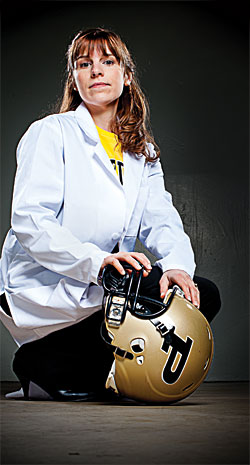Student entrepreneur aims to head off concussions
One of the first projects that Zakrajsek, a first-year doctoral student in mechanical engineering, will help to commercialize will likely benefit people in helmets who are in danger of concussive brain injuries, including football players and, eventually, soldiers.
Her project to redesign padding for football and other helmets takes a systematic approach to the problem by protecting wearers from concussive forces with multiple energy absorption mechanisms. The system is being tested using standard protocols in order to make improvements on the next design iteration, Zakrajsek says.

The helmet system stems from the work done for her master's thesis and as a graduate research assistant in the Purdue Neurotrauma Group (PNG) and for biomedical and mechanical engineering professor Eric Nauman, a mentor who is himself an entrepreneur.
It was during the data collection time that the team saw the magnitude and frequency of the impacts.
"It was apparent that the current helmets available were not fulfilling their purpose of mitigating impacts," Zakrajsek says. "The obvious next step was to work on designing our own helmet system to better protect against the hits we were seeing."
Zakrajsek told the Purdue Exponent in March that the helmet material was a novel idea designed in parallel with their concussion research.
"We looked at multiple mechanisms for deformation absorption, whereas some of the padding you see in existing helmets only have one mode of energy absorption," she says. "We designed this from the ground up and that's something that hasn't necessarily been done before."
Zakrajsek is pleased to be part of the development of materials and their potential use in safety equipment for military personnel. Blast testing has been conducted on the material in the Zucrow laboratory of Steven Son, professor of mechanical engineering.
"It's exciting to think that what you're doing in the lab could eventually help soldiers who are fighting for our country," she says.
So what's her future goal after earning her PhD? "Ultimately, I would like to start a program at Purdue in which design students develop custom assistive technology solutions for disabled persons," Zakrajsek says. "I believe that engineers need to play a more direct role in the care of disabled persons, especially when it comes to assistive technology and rehabilitation. As engineers, we are problem solvers. Instead of seeing a finite solution to a disability, we can think outside the box and design custom devices that ultimately increase functionality in our patients."
